
Saving Face
Disfigurement and the Politics of Appearance
Seiten
2014
New York University Press (Verlag)
978-0-8147-8410-5 (ISBN)
New York University Press (Verlag)
978-0-8147-8410-5 (ISBN)
Imagine yourself without a face - the task seems impossible. The face is a core feature of our physical identity. Our face is how others identify us and how we think of our 'self'. This book examines the cultural meaning and social significance of interventions aimed at repairing faces defined as disfigured.
Winner, Body and Embodiment Award presented by the American Sociological Association
Imagine yourself without a face—the task
seems impossible. The face is a core feature of our physical identity. Our face
is how others identify us and how we think of our ‘self’. Yet, human faces are
also functionally essential as mechanisms for communication and as a means of
eating, breathing, and seeing. For these reasons, facial disfigurement can
endanger our fundamental notions of self and identity or even be life threatening,
at worse. Precisely because it is so difficult to conceal our faces, the
disfigured face compromises appearance, status, and, perhaps, our very way of
being in the world.
In Saving Face, sociologist Heather Laine
Talley examines the cultural meaning and social significance of interventions
aimed at repairing faces defined as disfigured. Using ethnography,
participant-observation, content analysis, interviews, and autoethnography,
Talley explores four sites in which a range of faces are “repaired:” face
transplantation, facial feminization surgery, the reality show Extreme Makeover, and the international charitable
organization Operation Smile,. Throughout, she considers how efforts focused on
repair sometimes intensify the stigma associated with disfigurement. Drawing
upon experiences volunteering at a camp for children with severe burns, Talley also
considers alternative interventions and everyday practices that both challenge
stigma and help those seen as disfigured negotiate outsider status.
Talley delves into the promise and
limits of facial surgery, continually examining how we might understand
appearance as a facet of privilege and a dimension of inequality. Ultimately,
she argues that facial work is not simply a conglomeration of reconstructive
techniques aimed at the human face, but rather, that appearance interventions
are increasingly treated as lifesaving work. Especially at a time when
aesthetic technologies carrying greater risk are emerging and when
discrimination based on appearance is rampant, this important book challenges
us to think critically about how we see the human face.
Winner, Body and Embodiment Award presented by the American Sociological Association
Imagine yourself without a face—the task
seems impossible. The face is a core feature of our physical identity. Our face
is how others identify us and how we think of our ‘self’. Yet, human faces are
also functionally essential as mechanisms for communication and as a means of
eating, breathing, and seeing. For these reasons, facial disfigurement can
endanger our fundamental notions of self and identity or even be life threatening,
at worse. Precisely because it is so difficult to conceal our faces, the
disfigured face compromises appearance, status, and, perhaps, our very way of
being in the world.
In Saving Face, sociologist Heather Laine
Talley examines the cultural meaning and social significance of interventions
aimed at repairing faces defined as disfigured. Using ethnography,
participant-observation, content analysis, interviews, and autoethnography,
Talley explores four sites in which a range of faces are “repaired:” face
transplantation, facial feminization surgery, the reality show Extreme Makeover, and the international charitable
organization Operation Smile,. Throughout, she considers how efforts focused on
repair sometimes intensify the stigma associated with disfigurement. Drawing
upon experiences volunteering at a camp for children with severe burns, Talley also
considers alternative interventions and everyday practices that both challenge
stigma and help those seen as disfigured negotiate outsider status.
Talley delves into the promise and
limits of facial surgery, continually examining how we might understand
appearance as a facet of privilege and a dimension of inequality. Ultimately,
she argues that facial work is not simply a conglomeration of reconstructive
techniques aimed at the human face, but rather, that appearance interventions
are increasingly treated as lifesaving work. Especially at a time when
aesthetic technologies carrying greater risk are emerging and when
discrimination based on appearance is rampant, this important book challenges
us to think critically about how we see the human face.
Heather Laine Talley is Assistant Professor of Sociology at Western Carolina University. More about her writing and work can be found at www.heatherlainetalley.com.
Acknowledgments Introduction 1 About Face 2 Facial Work: Aesthetic Surgery as Lifesaving Work 3 Making Faces: Life Makeovers through Facial Work 4 Not Just Another Pretty Face: The Social Value of Unremarkability 5 Saving Face: Redeeming a Universal Face 6 Facing Off: Debating Facial Work, Constructing a "Vital" Intervention 7 At Face Value Losing Face: A Postscript Appendix: Methods, Methodologies, and Epistemologies Notes References IndexAbout the Author
| Verlagsort | New York |
|---|---|
| Sprache | englisch |
| Maße | 153 x 229 mm |
| Themenwelt | Medizin / Pharmazie ► Medizinische Fachgebiete ► Dermatologie |
| Sozialwissenschaften ► Soziologie | |
| ISBN-10 | 0-8147-8410-0 / 0814784100 |
| ISBN-13 | 978-0-8147-8410-5 / 9780814784105 |
| Zustand | Neuware |
| Haben Sie eine Frage zum Produkt? |
Mehr entdecken
aus dem Bereich
aus dem Bereich
Differentialdiagnostik und Therapie bei Kindern und Jugendlichen
Buch (2022)
Thieme (Verlag)
CHF 191,00
Allergene - Diagnostik - Therapie
Buch (2022)
Thieme (Verlag)
CHF 249,00
richtig verschreiben – individuell therapieren
Buch (2023)
Thieme (Verlag)
CHF 99,40


